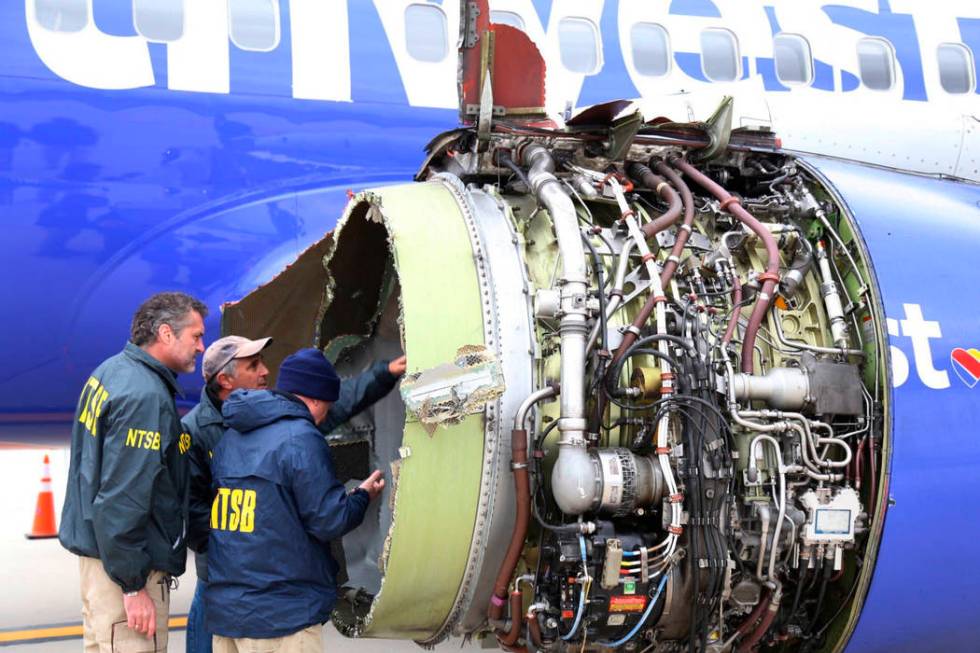Southwest jet made multiple Las Vegas flights before engine failure

The Southwest Airlines jetliner that made an emergency landing in Philadelphia had passed through Las Vegas and Reno multiple times in the two days leading up to an engine explosion, according to records maintained by flightaware.com.
It was unclear whether the Boeing 737 aircraft was serviced during five stops logged Sunday and Monday at McCarran International Airport and two stops at Reno/ Tahoe International Airport prior to the engine failure on Tuesday.
Southwest spokesman Dan Landon on Wednesday said the company was unable to comment on the plane’s stops or maintenance records because they are part of a wider investigation underway by the National Transportation Safety Board.
“I know it’s not ideal, but the NTSB owns the investigation and we are simply a party to it,” Landson said.
Investigators say a fan blade snapped off as Southwest Flight 1380 cruised at 500 mph high above Pennsylvania. The failure set off a catastrophic chain of events that killed a woman and broke a string of eight straight years without a fatal accident involving a U.S. airliner.
“This fan blade was broken right at the hub, and our preliminary examination of this was there is evidence of metal fatigue where the blade separated,” NTSB Chairman Robert Sumwalt said.
On Wednesday, federal investigators were still trying to determine how a window came out of the plane, killing a woman seated in that row. No plastic material from the window was found in the 737, Sumwalt told a news conference.
Family members have identified the woman as 43-year-old Jennifer Riordan, a banking executive and mother of two from Albuquerque, New Mexico. Passengers say Riordan was partially sucked out of the window after the plane was hit by engine debris.
Investigators also said the plane landed at a much faster-than-normal speed because the pilots were concerned about losing control if they flew slower.
The 737 landed at about 190 mph. A typical jet of that size lands at around 155 mph, Sumwalt said.
The leading edge of the left wing was damaged by the shrapnel produced by the explosion at 30,000 feet, officials added.
Earlier incident
Metal fatigue — microscopic cracks that can splinter open under the kind of stress placed on jetliners and their engines — was blamed for an engine failure on a Southwest plane in Florida in 2016. Both that plane and the jet that made a harrowing emergency landing Tuesday in Philadelphia were powered by CFM56 engines.
Manufacturer CFM International, a joint venture of General Electric Co. and France’s Safran SA, recommended last June that airlines using certain CFM56 engines conduct ultrasonic inspections to look for cracks.
Last month, European regulators required airlines flying in Europe to conduct the inspections that were recommended by CFM.
In the U.S., the Federal Aviation Administration proposed a similar directive last August but has not yet required the inspections.
The FAA proposal would have given airlines six months to inspect the fan blades on engines that had flown more than 7,500 flights, and 18 months on more lightly used engines.
It is unclear whether that would have forced Southwest to quickly inspect the engine that blew up. CEO Gary Kelly said it had logged only 10,000 cycles since being overhauled.
Critics accuse the FAA of inaction in the face of a threat to safety.
Robert Clifford, a lawyer who is suing American Airlines over another engine explosion that caused a fire that destroyed the plane, said the FAA should have required the inspections — even if it meant grounding Boeing 737s.
“There is something going on with these engines,” he said, “and the statistical likelihood of additional failures exists.”
Too soon to tell
The Southwest CEO protested that it is too soon to say whether Tuesday’s incident is related to any other engine failures.
Kelly said Tuesday’s plane had flown 40,000 cycles. A cycle is one takeoff and one landing. Boeing delivered the plane to Southwest in July 2000, meaning that if the plane has been in continuous use it has made about three flights a day.
Kelly said the plane was inspected on Sunday and nothing appeared out of order.
There are several types of inspections that airline planes must go through, ranging from an “A check,” which is done about every eight to 10 weeks, to more-rigorous B, C and D checks.
A so-called D check is done roughly every six years for older planes, less frequently for newer ones. It can take weeks and involves taking apart much of the plane for inspection and possible repair or replacement of parts, then putting it back together. Engines are typically removed for work during a D check.
Southwest did not respond to repeated requests to make maintenance records for Tuesday’s plane available to The Associated Press, but NTSB investigators were heading to Dallas to inspect the records, Sumwalt said.